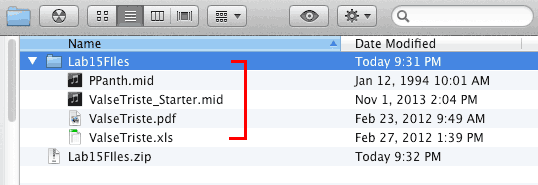
Valse Triste is a composition by Jean Sibelius and will be used as the example MIDI file in most of the remaining labs.
Download Lab15FIles.zip. Unzip the files and copy the Lab15Files folder to your Desktop.

Open a new Empty project with a single software instrument.
Choose Open from the File menu in Logic and Open the ValseTriste_Starter.mid file.
They're no longer needed. Select in Inspector panel and type delete.
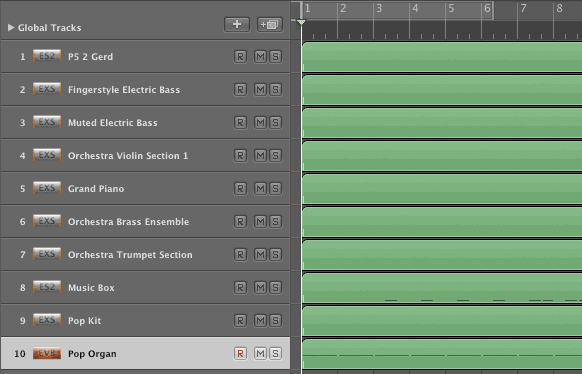
Expand the Global Tracks pane and expand the Signature pane.
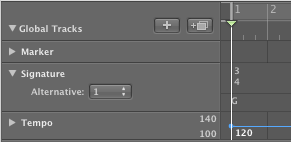
The Time Signature should be set to 3/4, the Key Signature should be G, and the Tempo to 120.
Minimize Global Tracks.
Save as 15VTLab1. Save to the Desktop.
This is a precaution so you don't have to start over.
IMPORTANT: Do not work on projects that are stored on your USB drive or in your network home folder. They are not fast enough to process data reliably. ALWAYS work on Logic projects that are copied to the local computer, either on the Desktop or in your home folder.
I will save often. I will save often. I will make backups. I will make backups.
Often is once every 1-2 minutes.
If the track end marker (box) is out of place, move it.
You can drag the box ...
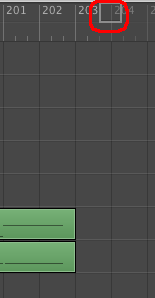
... or double click and reset it here.

Logic tries to guess what instruments are in the MIDI file by looking for patch changes and instrument names for each track. In this case it did not do a very good job.
![]()
The instruments in the score are:
Track |
Score Name | English Name | Abbreviation |
1 |
Flauto | Flute | Fl |
2 |
Clarinetto in A | Clarinet | Clar |
3 |
Corni in F | French Horn 1 | Hrn1 |
4 |
Corni in F | French Horn 2 | Hrn2 |
5 |
Timpano in D | Timpani | Timp |
6 |
Violino I |
Violin 1 | Vln1 |
7 |
Violino II | Violin 2 | Vln2 |
8 |
Viola | Viola | Vla |
9 |
Violoncello | Cello | Vlc |
10 |
Basso | Contrabass | Cb |
Because this is an orchestral piece we'll use the EXS24 Sampler for all tracks. In your final project, you can assign any software instrument to any track as you did in 14Lab1.
Click the Mixer tab near the lower left of the main window.
Then click and hold the PS2 Gerd button at the top of Mixer channel strip 1 and choose the EXS24 Sampler instrument.
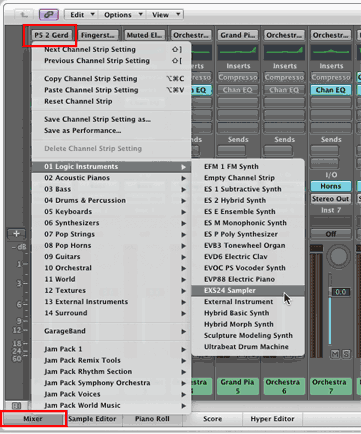
Reassign all 10 tracks to the EXS24 instrument.
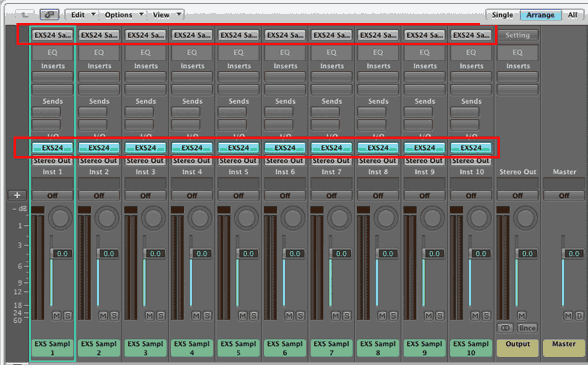
Double click the I/O button in the Inspector panel.
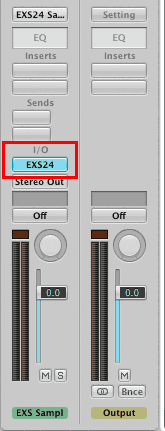
When the EXS24 window appears select the 09 Orchestral > 01 Woodwinds > Flute Solo preset.
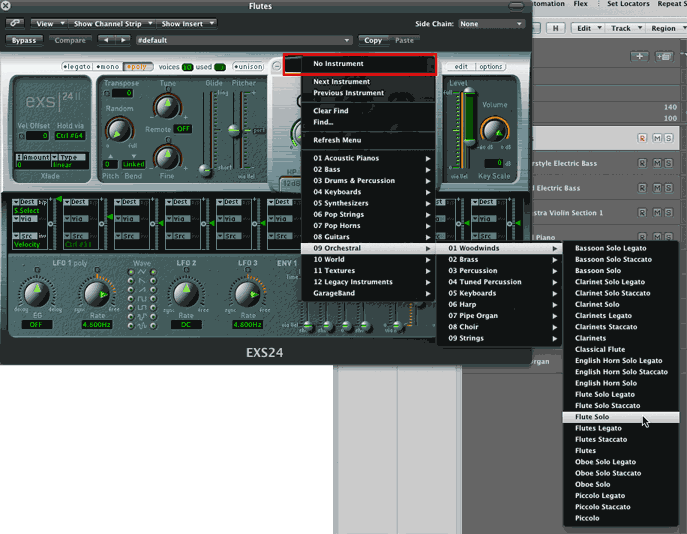
Close the EXS24 window.
Double click the I/O button in the Inspector panel.

When the EXS24 window appears select the Clarinet Solo preset from 09 Orchestral > 01 Woodwinds.
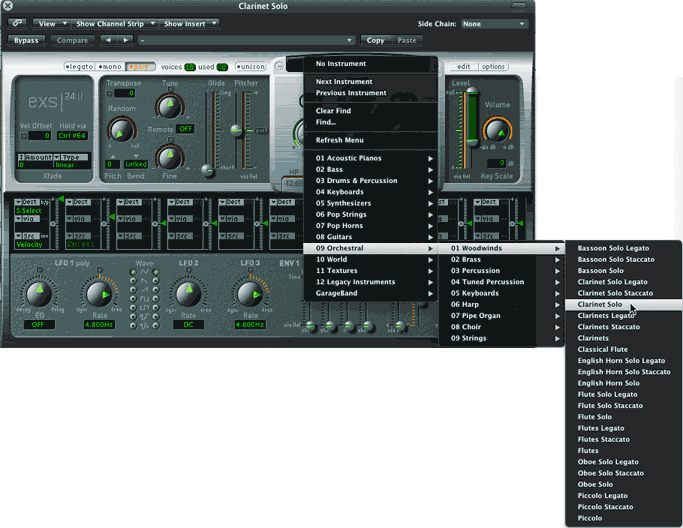
Keep the EXS24 window open.
Use the Show Channel Strip popup menu to select track each of the remaining channel strips.

Make these assignments.
Channel Strip |
Name | EXS24 Instrument |
1 |
Flute | 09 Orchestral > 01 Woodwinds > Flute Solo |
2 |
Clarinet | 09 Orchestral > 01 Woodwinds > Clarinet Solo |
3 |
French Horn 1 | 09 Orchestral > 02 Brass> French Horn Solo |
4 |
French Horn 2 | 09 Orchestral > 02 Brass> French Horn Solo Legato |
5 |
Timpani | 09 Orchestral > 04 Tuned Percussion > Timpani |
6 |
Violin 1 | 09 Orchestral > 09 Strings > Violins 1 Legato |
7 |
Violin 2 | 09 Orchestral > 09 Strings > Violins 2 Legato |
8 |
Viola | 09 Orchestral > 09 Strings > Violas Legato |
9 |
Cello | 09 Orchestral > 09 Strings > Cellos Legato |
10 |
Contrabass | 09 Orchestral > 09 Strings > Basses Pizzicato |
The track names in the Inspector Panel should look like this.
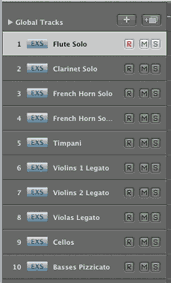
Close the Mixer Window.
Select all green MIDI tracks.
Choose Name Regions by Tracks/Channel Strips from the Region menu.
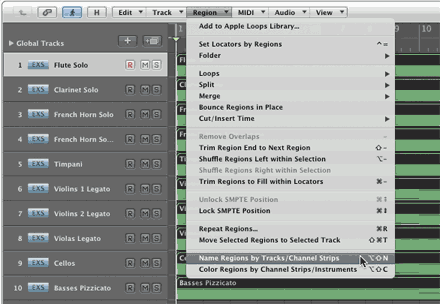
The instrument names should appear in the track titles.
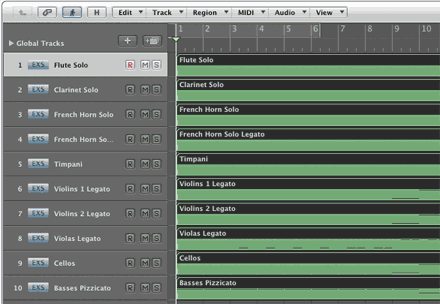
Cick the samll icon in the Inspector panel and select the Icon that represents the flute.
![]()
After assigning track Icons.
![]()
Open the Event tab in the Lists view.
Click the Additional Info button and then click the Notes button. Unlike most buttons, when Event List buttons are turned on they filter out (turn off) the display of those MIDI events.
Delete the the five control messages.
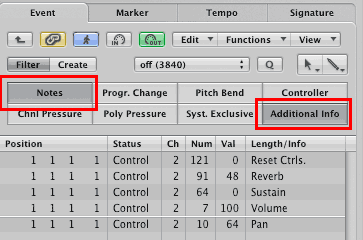
Do the same for the remaining nine tracks.
Save often, at least once every 1-2 minutes.
Open the Mixer, select track 1, and choose Colors from the View menu.
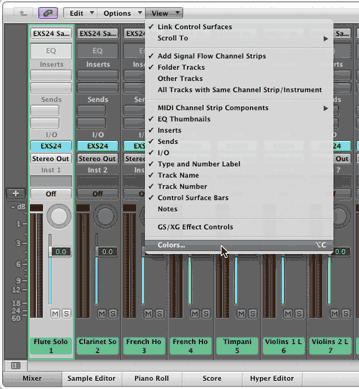
Select a track, then click a color.
Do not have to close the color panel.
Type left arrow and choose a color for track 2. Continue for all tracks.
Close the color panel.

Close the Mixer.
Select all 10 MIDI tracks and choose Color Regions by Channel Strips/Instruments from the Region menu.
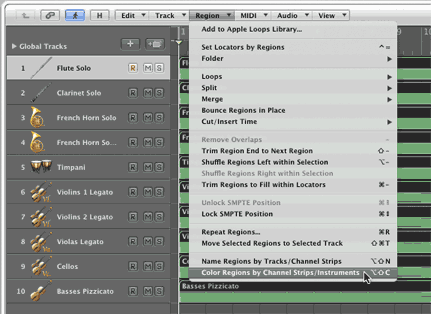
After.
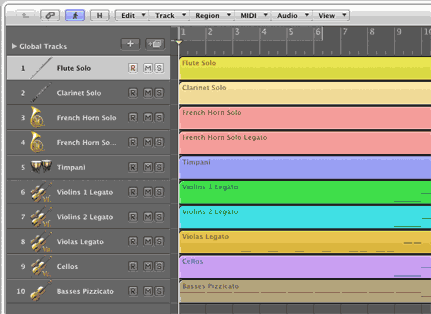
Save and save often.
Play a portion of the song. Granted, it's not very interesting yet.
Open ValseTriste.pdf. Arrange your windows so you can see Logic, ValseTriste, and this Web page.
Although not required it is recommended that you create and print out a score for your final project piece. You can open a MIDI file in Sibelius to see the notation. Sibelius can print to a printer or Export to a PDF file. You can always ask me for help if you have questions or problems creating a score.
The ValseTriste score has measure numbers at the top left of every system.
The score uses rehearsal letters A - O to mark significant sections in the score. We'll create markers in Logic to make it easy to navigate to any of those sections. Click the Lists icon and choose the Marker tab. In the following steps you'll create create Logic Markers to match up with measure numbers in your score.
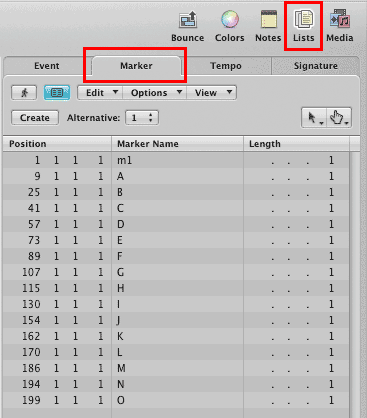
Click the create button 16 times to create a 16 markers.
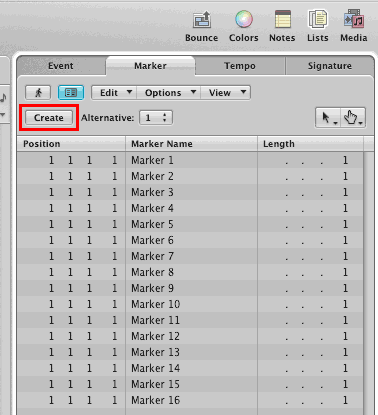
Double click the Marker 2 position line.
Type 9 and press enter.
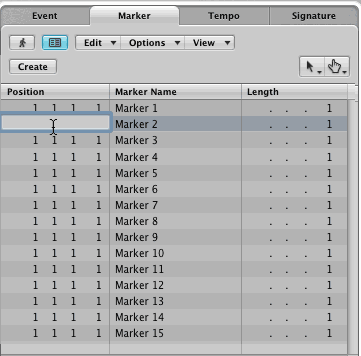
Markers are sorted by measure number and measure 9 now appears. at the bottom of the list.
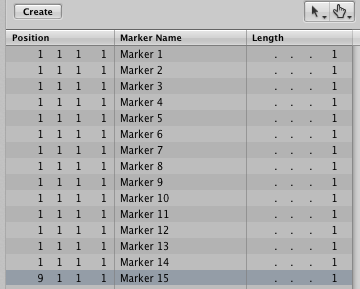
Click Marker 2 again and enter the starting measure for each of the remaining markers.
When completed your list will look like this.
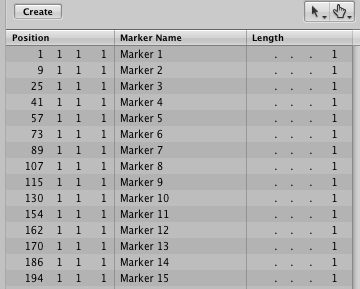
Double click Marker Name text and enter the text in the lower third of the window.
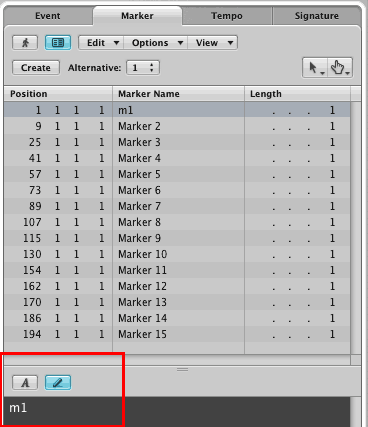
Your completed Marker list should look like this.
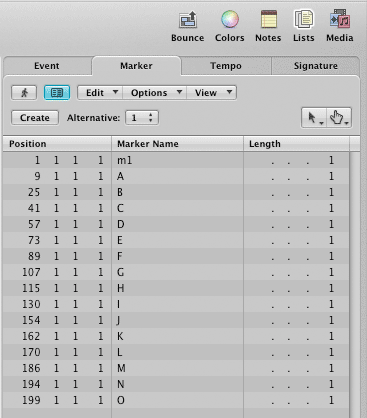
Valse Triste uses the following ten instruments.
| Score Name | English Name | Abbreviation |
| Flauto | Flute | Fl |
| Clarinetto in A | Clarinet | Clar |
| Corni in F | French Horn 1 | Hrn1 |
| Corni in F | French Horn 2 | Hrn2 |
| Timpano in D | Timpani | Timp |
Violino I |
Violin 1 | Vln1 |
| Violino II | Violin 2 | Vln2 |
| Viola | Viola | Vla |
| Violoncello | Cello | Vlc |
| Basso | Contrabass | Cb |
There are a number of musical symbols and text elements that indicate how the piece is to be performed. These symbols fall into four broad categories:
The following musical terms are used in the score:
| Term | Definition |
| deciso | decisive, energetic |
| dolce | sweetly |
| espress. | expressively |
| meno | less |
| molto | much more |
| piu | more |
| poco a poco | more |
| risoluto | resolved, bold |
| segue | continue in the same manner |
The following musical terms are often used as adjectives to modify dynamics and tempo.
| Adjective | Definition |
| meno | less |
| molto | much more |
| piu | more |
| poco a poco | little by little |
The following dynamic markings are used in the score. Dynamics refer to how loud and soft the sound is.
| ppp | very very soft |
| pp | very soft |
| p | soft |
| mp | medium soft |
| mf | medium loud |
| f | loud |
| ff | very loud |
| cresc | getting louder |
| deciso | decisive, energetic |
| decresc | getting softer |
| dim | getting softer |
| dolce | sweetly |
| espress. | expressively |
| risoluto | with resolve, bold |
| crescendo, getting louder | |
| decrescendo, getting softer |
| Term | Definition |
| a Tempo | return to original tempo |
| , | comma indicates a breath mark - slight pause in music |
| breit | broad, slow tempo |
| deciso | decisive, energetic |
| fermata | pause at the discretion of the performer |
| Lento | slow |
| mosso | motion, agitated |
| rall | gradual slowing |
| rit | gradual slowing |
| Stretto | quickening of tempo |
| Term | Symbol | Definition |
| staccato | . | short, detached |
| legato | curved line | smoothly connected |
| slur | curved line over two notes of different pitch | second note is shorter and slightly softer than first note |
| tenuto | _ | emphasize |
| accent | > | louder than surrounding notes |
| sforzando | ffz, sfz | louder than an accent |
The following bowing techniques are used in the score:
| Measure | Type | Symbol | Definition |
| 1 | con sordini | with mute | |
| 9 | Slur | smooth, second note softer and slightly shorter |
|
| 41 | Spitze. |
point of the bow | |
| 56 | Loure | multiple notes on one bow with separate pressure on each note, each note has a slight separation |
|
| 70 | legato | smooth | |
| 83 | pizzicato | plucked, not bowed | |
| 87 | arco | bowed | |
| 89 | separate | separate bow strokes each note, still smooth | |
| 130 | marcato martele |
hammer like bowing, bow stopped abruptly at end of stroke |
You should create an Excel spreadsheet of indicating the tempo, dynamics, instruments, and articulations used in the score. Here's an Excel spreadsheet for Valse Triste. The chart only shows the strings. The winds and brass expression marking are easy to see in the score.
| Measure | Marker | Tempo | Dynamics | Vln1 | Vln2 | Vla | Vlc | Cb |
| 1 | 0 | Lento | p | mute | mute | mute | mute | pizz |
| 3 | pizz | Pizz | ||||||
| 7 | arco | arco | ||||||
| 9 | A | p dolce | ||||||
| 12-13 | cresc | |||||||
| 14-16 | decresc | |||||||
| 21-22 | cresc | |||||||
| 23-2 | decresc | |||||||
| 25 | B | |||||||
| 27-28 | cresc | |||||||
| 31-32 | decresc | |||||||
| 39 | cresc | |||||||
| 40 | rall. | decresc | ||||||
| 41 | C | a Tempo, deciso | pp | spiz | spiz | spiz | spiz | |
| 55 | cresc | |||||||
| 56 | poco rall | decresc | arco | arco | arco | arco | ||
| 57 | D | a tempo | piu pp | spiz | spiz | spiz | spiz | |
| 65-66 | cresc | |||||||
| 67-68 | dim | |||||||
| 69-70 | p cresc | arco | arco | arco | arco | |||
| 71 | deciso | mp deciso decresc | ||||||
| 73 | E | fl vln mf espress. | pizz | |||||
| 75 | clar vla mf | |||||||
| 76 | decresc | |||||||
| 77 | mp dim | |||||||
| 80 | pp | |||||||
| 83-84 | pizz | |||||||
| 85 | mp | |||||||
| 86 | dim | |||||||
| 89 | pp | arco | ||||||
| 89 | F | p cresc | arco | |||||
| 93-94 | breit | f | ||||||
| 95 | dim molto | |||||||
| 98 | pp | |||||||
| 98 end | Grand Pause | |||||||
| 99 | mp | |||||||
| 102 | rit | |||||||
| 102 end | breath mark | |||||||
| 103 | Lento | ppp | ||||||
| 104 | cresc | |||||||
| 105-106 | decresc | |||||||
| 106 end | Grand Pause | |||||||
| 107 | G | a tempo | p dolce | |||||
| 109-110 | cresc | |||||||
| 112-113 | decresc | |||||||
| 115 | H | mp dolce | pizz | |||||
| 117 | pizz | |||||||
| 120 | arco | |||||||
| 121 | ||||||||
| 123 | p cresc | arco | ||||||
| 126 | mf | |||||||
| 127 | f | |||||||
| 129 | decresc | |||||||
| 130 | I | poco risoluto | f | marcato | marcato | |||
| 131 | pizz | pizz | arco | |||||
| 134 | arco | arco | ||||||
| 138 | marcato | marcato | ||||||
| 141 | arco | arco | ||||||
| 143-145 | cresc | |||||||
| 146 | f | |||||||
| 154 | J | piu f | ||||||
| 162 | K | piu risoluto e mosso | ff | arco | arco | |||
| 170 | L | Stretto | f | |||||
| 183-185 | decresc | |||||||
| 186 | M | f | ||||||
| 194 begin | N | Grand Pause | ||||||
| 194 end | meno | meno f | ||||||
| 195 | mf | pizz | ||||||
| 197-198 | decresc | |||||||
| 199 | pp | |||||||
| 200-202 | decresc |
We'll add these articulations and dynamics in future labs.
Save